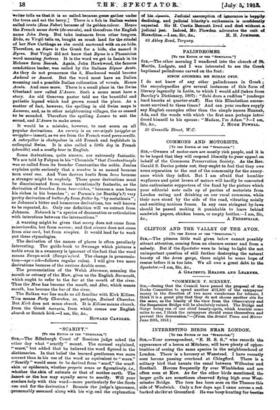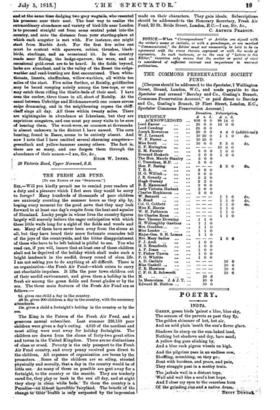INTERESTING BIRDS NEAR LONDON.
[To TRZ EDITOR Or THE ..evreureE."] STR,—Your correspondent, "E. H. S. S.," who records the appearance of a heron at Mitcham, will have plenty of oppor- tunities of seeing the same species in the neighbourhood of London. There is a heronry at Wanstead. I have recently seen herons passing overhead at Chingford. There is a solitary bird that haunts the canal- between Willesden and Southall. Herons frequently fly over Wimbledon and are often seen at Kew. As for the other birds mentioned, the larger gulls are sometimes observed flying high over West- minster Bridge. The tern has been seen on the Thames this side of Woolwich. Only a few days ago I came across a red- -backed shrike-at Greenford: He was buwthuntingfor beetles andnt the Same time dodging two grey wagtails, who resented his presence near their nest.. The best way to realize the extraordinary abundance and variety of bird-life near London is to proceed straight out from some central point into the country, and note the distance from your starting-place at which each songster is met with. For instance, one might start from Marble Arch. For the first five miles one must be content with sparrows, robins, thrill/sites, black- birds, starlings, and an occasional tit. In the country roads near Ealing, the hedge-sparrow, the wren, and an oecalional gold-crest are to be heard. In the fields beyond, larks are abundant, and in the valley of the Brent the sedge- warbler and reed-bunting are first encountered. Then white- :throats, linnets, chaffinches, willow-warblers, all within ten miles of the start. Five miles further, at Ruislip, goldfinches may be heard romping noisily among the tree-tops, or one may catch them rifling the thistle-beds of their seed. I have Seen the curlew, three times in all, short of Ruislip. At the canal between Uxbridge and Rickmansworth one comes across snipe drumming, and in the neighbouring copses the chiff- chaff sings all day. All these within twenty miles. There are nightingales in abundance at Ickenham, but they are capricious songsters, and one must pay many visits to be sure of hearing them. The wood-wren, so common at Sevenoaks is almost unknown in the district I. have named. The corn bunting, found in Essex, seems to be entirely absent. And now I note that I have omitted several charming songsters— greenfinch and yellow-hammer among others. The fact is, there are so many, and one forgets them through the abundance of their names.—I am, Sir, &c.,
Hnos W. INNEs.
28 Victoria Road, Upper Norwood, S.E.



















































 Previous page
Previous page